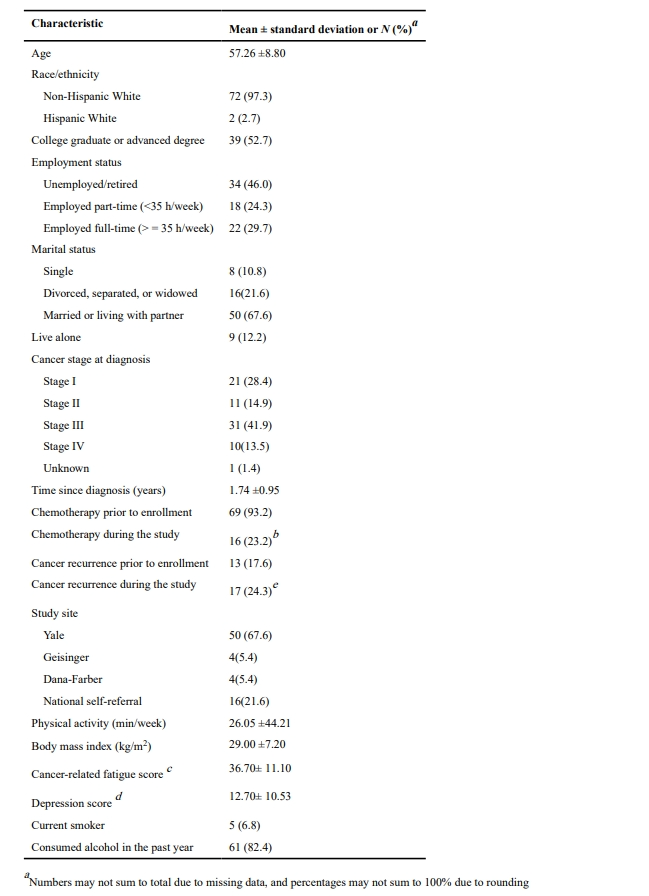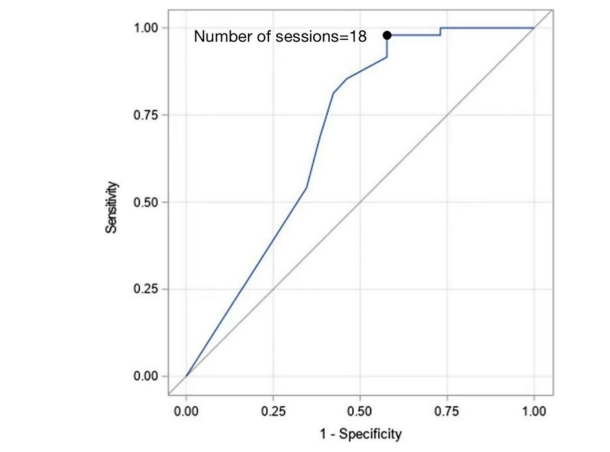卵巢癌是女性中最常见的癌症之一,晚期诊断率高。耶鲁大学公共卫生学院的研究者发表于J Cancer Surviv的一篇研究表明[1],通过电话咨询的途径干预,探索了提高卵巢癌幸存者运动水平的可能性。结果显示,参与更多的咨询会议和无癌症复发与更好的运动目标达成率相关。这项研究为未来设计更有效的干预方案提供了重要线索,有望改善卵巢癌幸存者的生活质量。【肿瘤资讯】特对主要内容进行整理,以飨读者。
研究背景
卵巢癌是女性癌症相关死亡的第五大原因,也是最致命的妇科肿瘤[2]。由于缺乏有效的筛查工具,60%的卵巢癌在晚期才被诊断。III期和IV期患者的5年生存率分别为42%和26%[3],降低了治疗成功的机会。
已有研究证明,运动干预有助于改善卵巢癌幸存者的生活质量、癌症相关疲劳、抑郁症状和身体成分[4-9]。观察性研究显示,体力活动更多的卵巢癌幸存者生存率更高[10,11]。美国癌症协会(ACS)建议癌症幸存者每周至少进行150分钟的中等强度运动[12]。然而,大多数被诊断为卵巢癌的女性未达到此运动建议水平[13],这突显了改善该人群体力活动水平的重要性。
迄今为止,已有10项研究设计了提高卵巢癌幸存者运动水平的干预措施[5,7–9,14–19],其中4项为随机对照试验[5,9,18,19],其中2项研究报告了迄今为止的主要结果[5,9]。但是,这些试验的观察到的疗效在很大程度上取决于受试者对运动干预的依从性。
本研究旨在探索提高卵巢癌幸存者锻炼水平的干预措施,并分析与锻炼目标达成率相关的因素。尽管已有研究表明锻炼干预可以改善卵巢癌幸存者的生活质量和身体状况,但现有干预方案的效果仍受到参与者对干预的遵循程度影响。因此,研究旨在解决以下问题:卵巢癌患者在参与锻炼干预过程中的遵循程度受到哪些因素的影响?需要多少次运动咨询会议才能使患者达到推荐的锻炼水平?通过对康涅狄格州妇女活动与生活方式研究(WALC)的二次分析,研究者希望为未来设计更有效的干预措施提供重要线索,以改善卵巢癌患者的生活质量和长期生存率。
方法
WALC研究是一项针对卵巢癌患者的运动干预试验。在2010年5月1日至2014年3月20日期间,该研究招募了144名接受卵巢癌治疗的女性,他们被随机分配到6个月的运动干预组(N = 74)或注意力控制组(N=70)。纳入标准包括年龄在18至75岁之间,能够说英语,已被诊断为I-IV期卵巢癌,已完成至少一个月的化疗,每周运动时间少于90分钟,并获得医生同意参加研究。
基线测量包括身高、体重、癌症相关疲劳(使用FACT-F问卷评估)、抑郁症状(使用CES-D评估)和身体活动水平(评估过去6个月内20次娱乐活动的持续时间和频率)。
运动干预组接受了基于家庭的中等强度有氧运动,由经过美国运动医学会(ACSM)认证的癌症运动教练每周通过电话指导。根据美国癌症学会(ACS)指南,建议女性将运动量增加至每周150分钟,进行中等强度有氧运动[12],主要通过快走。该试验中的锻炼侧重于结构化锻炼,而不是家务等日常活动。研究中使用的咨询会议是基于社会认知理论,通过电话进行,旨在提高参与者的运动水平。干预期间,参与者记录了他们的运动持续时间和类型,并与教练进行了每周一次的电话咨询会议。
研究结果
在WALC运动干预研究中,女性卵巢癌患者的平均年龄为57.3± 8.8 岁,平均BMI为28.7 ± 6.9kg/m²,平均自卵巢癌诊断至研究参与的时间为1.7年± 1.0 年(表1)。所有参与者被确诊为上皮性卵巢癌,55.4%的女性患有晚期(El期或IV期)卵巢癌。所有患者(100%)在入组前接受了手术,93.2%接受了化疗。17%的参与者在研究前有疾病复发,24.3%的参与者在研究期间有复发。在基线时,平均每周有 26.1 ± 44.2 分钟的运动。
在6个月的试验期间,平均运动时间为166.0分钟/周,64.9%的参与者达到了每周150分钟的运动目标。
表1 WALC运动干预组患者基线

研究发现,未在研究期间出现肿瘤复发、非主动参与、基线身体活动水平较高、基线癌症相关疲劳和抑郁水平较低,以及参与咨询会议次数更多与更好的运动干预依从性相关。多变量分析显示,未在研究期间出现癌症复发以及参与咨询会议的次数与达到运动目标的概率显著相关。此外,参与咨询会议次数更多和基线较高的身体活动水平与每周平均运动持续时间的增加相关。根据未经调整的ROC曲线,接受18次线上咨询会议是预测达到每周150分钟运动目标的最佳截止点(图1)。总的来说,这项研究回答了卵巢癌患者参与运动干预并达到运动目标的相关因素,以及运动干预的依从性和持续时间的关联问题。
 图1 满足每周150分钟运动目标的接受咨询会议次数的受试者工作特征(ROC)曲线。
图1 满足每周150分钟运动目标的接受咨询会议次数的受试者工作特征(ROC)曲线。
a 使用简单逻辑回归生成。因变量:达到每周150分钟目标(是/否);自变量:参加的咨询会议次数。曲线下面积=0.7003。最佳截止点是由黑色圆点表示的预测概率为0.40,即曲线的肩点(最接近左上角)。根据模型,预测概率0.40对应参加18次会议。
结论
在这项随机对照试验中,参加更多的线上咨询会议和研究期间没有癌症复发与卵巢癌幸存者与达到运动目标正相关。同时,较高的咨询会议参加率和基线运动水平与更长的运动持续时间相关。这项研究证实了通过电话咨询干预可以促进卵巢癌幸存者实现每周150分钟的运动目标,为未来设计干预方案提供了重要参考。
1.Cao A, Cartmel B, Li FY, Gottlieb LT, Harrigan M, Ligibel JA, Gogoi R, Schwartz PE, Irwin ML, Ferrucci LM. Exercise adherence in a randomized controlled trial of exercise on quality of life in ovarian cancer survivors. J Cancer Surviv. 2023 Apr;17(2):535-543. doi: 10.1007/s11764-022-01325-6.
2.Siegel RL, Miller KD, Fuchs HE, Jemal A. Cancer statistics, 2022. CA: A Cancer J Clin. 2022;72(1):7–33.
3.Torre LA, Trabert B, DeSantis CE, et al. Ovarian cancer statistics, 2018. CA Cancer J Clin. 2018;68(4):284–96.
4.Zhou Y, Cartmel B, Gottlieb L, et al. Randomized trial of exercise on quality of life in women with ovarian cancer: Women’s Activity and Lifestyle Study in Connecticut (WALC). J Natl Cancer Inst. 2017. Dec 1;109(12):djx072.
5.Cartmel B, Hughes M, Ercolano EA et al. Randomized trial of exercise on depressive symptomatology and brain derived neurotrophic factor (BDNF) in ovarian cancer survivors: the Women’s Activity and Lifestyle Study in Connecticut (WALC). Gynecol Oncol. 2021;161(2):587–94.
6.Cao A, Cartmel B, Li FY, et al. Effect of exercise on body composition among women with ovarian cancer. J Cancer Surviv. 2022. Apr 4: 10.1007/sll764-022-01207-x.
7.Mizrahi D, Broderick C, Friedlander M, et al. An exercise intervention during chemotherapy for women with recurrent ovarian cancer: a feasibility study. Int J Gynecol Cancer. 2015;25(6):985–92.
8.Newton MJ, Hayes SC, Janda M, et al. Safety, feasibility and effects of an individualised walking intervention for women undergoing chemotherapy for ovarian cancer: a pilot study. BMC Cancer. 2011;11:389.
9.Zhang Q, Li F, Zhang H, Yu X, Cong Y. Effects of nurse-led home-based exercise & cognitive behavioral therapy on reducing cancer-related fatigue in patients with ovarian cancer during and after chemotherapy: a randomized controlled trial. Int J Nurs Stud. 2018;78:52–60.
10.Zhou Y, Chlebowski R, LaMonte MJ, et al. Body mass index, physical activity, and mortality in women diagnosed with ovarian cancer: results from the Women’s Health Initiative. Gynecol Oncol. 2014;133(1):4–10.
11.Wang T, Townsend MK, Eliassen AH, et al. Prediagnosis and postdiagnosis leisure time physical activity and survival following diagnosis with ovarian cancer. Int J Cancer. 2021; 149(5): 1067–75.
12.Rock CL, Thomson CA, Sullivan KR, et al. American Cancer Society nutrition and physical activity guideline for cancer survivors. CA: Cancer J Clin. 2022;72(3):230–62.
13.Jones TL, Sandler CX, Spence RR, Hayes SC. Physical activity and exercise in women with ovarian cancer: a systematic review. Gynecol Oncol. 2020;158(3):803–11.
14.von Gruenigen VE, Frasure HE, Kavanagh MB, Lerner E, Waggoner SE, Courneya KS. Feasibility of a lifestyle intervention for ovarian cancer patients receiving adjuvant chemotherapy. Gynecol Oncol. 2011;122(2):328–33.
15.Sohl SJ, Danhauer SC, Schnur JB, Daly L, Suslov K, Montgomery GH. Feasibility of a brief yoga intervention during chemotherapy for persistent or recurrent ovarian cancer. Explore (NY). 2012;8(3):197–8.
16.Moonsammy SH, Guglietti CL, Santa Mina D, et al. A pilot study of an exercise & cognitive behavioral therapy intervention for epithelial ovarian cancer patients. J Ovarian Res. 2013;6(1):21.
17.Zhang X, McClean D, Ko E, Morgan MA, Schmitz K. Exercise among women with ovarian cancer: a feasibility and pre/post-test exploratory pilot study. Oncol Nurs Forum. 2017;44(3):366–74.
18.Thomson CA Crane TE, Miller A, Garcia DO, Basen-Engquist K, Alberts DS. A randomized trial of diet and physical activity in women treated for stage II-IV ovarian cancer: rationale and design of the Lifestyle Intervention for Ovarian Cancer Enhanced Survival (LIVES): an NRG Oncology/Gynecologic Oncology Group (GOG-225) Study. Contemp Clin Trials. 2016;49:181–9.
19.Stelten S, Hoedjes M, Kenter GG, et al. Rationale and study protocol of the Physical Activity and Dietary intervention in women with OVArian cancer (PADOVA) study: a randomised controlled trial to evaluate effectiveness of a tailored exercise and dietary intervention on body composition, physical function and fatigue in women with ovarian cancer undergoing chemotherapy. BMJ Open. 2020;10(11):e036854.
声明:材料由阿斯利康支持,仅供医疗卫生专业人士参考
审批号:CN-133399
排版编辑:肿瘤资讯-Rex











 苏公网安备32059002004080号
苏公网安备32059002004080号


